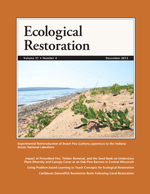
Partner society of Ecological Restoration journal celebrates major anniversary
This September, the Society for Ecological Restoration (SER) looked back on 30 years of bringing together scientists, practitioners, policymakers dedicated to reviving ecosystems around the world. Ecological Restoration journal, published by the University of Wisconsin Press, is a partner journal of SER. The roots of this partnership go deep: William R. Jordan III, who started the journal (originally named Restoration & Management Notes) in 1981, went on to become one of SER’s founders, along with John Reiger, Anne Sands, and John Stanley.
Since the Society was originally incorporated on September 28, 1988, SER’s membership has grown to nearly 3,000, comprising 13 active chapters. The organization has an international reach, holding biennial world conferences and drawing members from over 75 countries. Last year, SER launched the world’s first certification program for ecological restoration. Additionally, SER brings the latest information to members and the public through its online Restoration Resource Center, a database of publications and restoration projects, and its own peer-reviewed journal, Restoration Ecology.
SER’s growth is evidence of how far the field of restoration has come in the past 30 years. As John Reiger, the first SER board president, reflects in the organization newsletter’s anniversary issue, “The mainstreaming of restoration on the international stage, and its recognized role as an important part of climate change and other commitments means that both the global and local reach and vision of SER is more important—and exciting—than ever. But that global engagement should be balanced with continuing to serve a diverse mix of individual members that includes practitioners, academics, and land managers.”
 Current Ecological Restoration editor Steven N. Handel agrees that nurturing this diversity of roles is crucial for the success of the field: “The membership of SER is a mosaic of professionals, mirroring in its way the mosaic nature of so many of our habitats. Scientists, students, land managers, nursery operators, conservation organizations, and dedicated volunteers with environmental interests all turn to [SER and] Ecological Restoration. This is quite different from the membership of many science organizations, which is dominated by working scientists.” Handel says that Ecological Restoration has responded by ensuring that its contents are useful to a variety of different professionals, “emphasizing articles that are based on formal tests and that have generalizable findings, but making sure that the work has a practical side, so that practitioners can quickly use the results when working on the land.”
Current Ecological Restoration editor Steven N. Handel agrees that nurturing this diversity of roles is crucial for the success of the field: “The membership of SER is a mosaic of professionals, mirroring in its way the mosaic nature of so many of our habitats. Scientists, students, land managers, nursery operators, conservation organizations, and dedicated volunteers with environmental interests all turn to [SER and] Ecological Restoration. This is quite different from the membership of many science organizations, which is dominated by working scientists.” Handel says that Ecological Restoration has responded by ensuring that its contents are useful to a variety of different professionals, “emphasizing articles that are based on formal tests and that have generalizable findings, but making sure that the work has a practical side, so that practitioners can quickly use the results when working on the land.”
Handel sees design, particularly, as a key instrument in the toolkit of restorationists, especially given the unprecedented environmental challenges of the twenty-first century. He notes, “We have also invited the landscape architect crowd to visit our journal, hoping that designed natural landscapes, many installed on new sites, become a greater part of their efforts. The meshing of restoration and design work remains a critical part for the years ahead as SER members will be dealing with modified lands, changing with the climate, that will need design as well as management inputs.”
Clearly, it is more important than ever to cultivate innovation and conversation across the many disciplines working to restore ecosystems. In an era of intense professional specialization, where deep divides between academic scholarship and communities of practice are the norm, it is refreshing to witness the collaborative spirit that SER and Ecological Restoration have promoted for over three decades.
All SER memberships include a membership in the SER Chapter or Section of your choosing, discounts on Certified Ecological Restoration Practitioner program fees, reduced pricing on world conferences, subscriptions to monthly newsletters, complimentary webinars, and discounts on publications including Ecological Restoration. Learn more about membership and join the community: ser.org/join.














